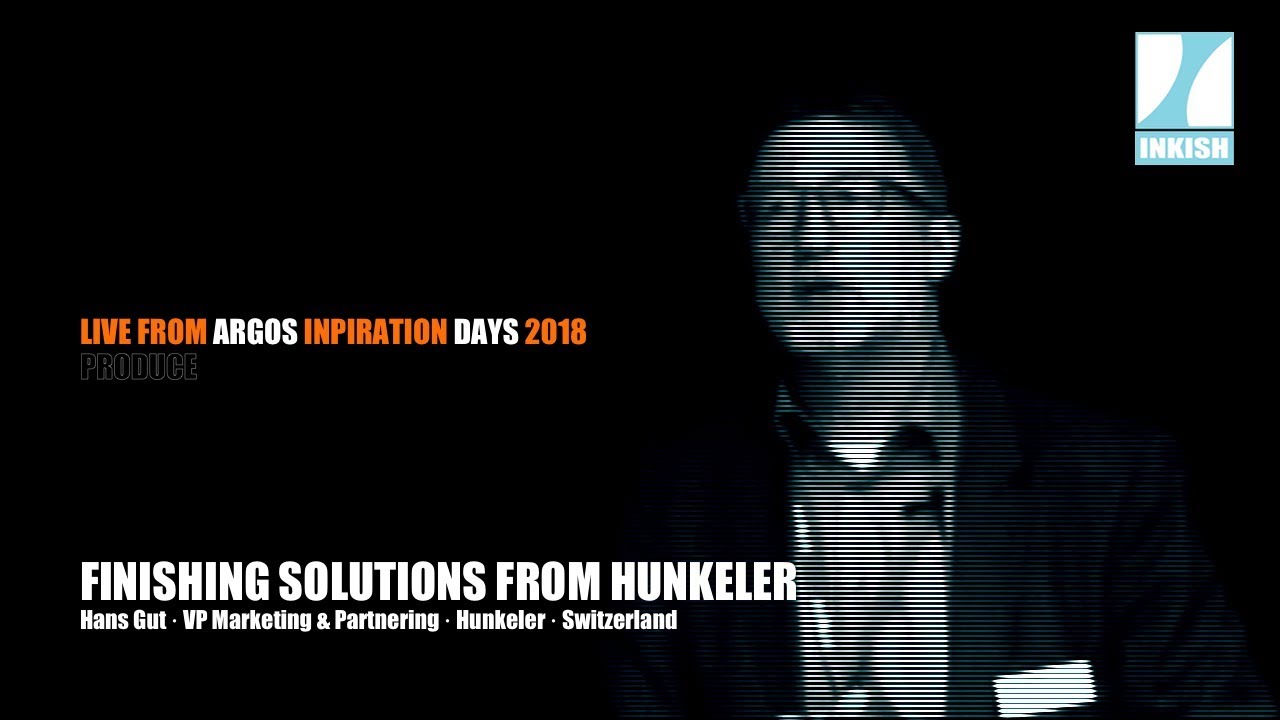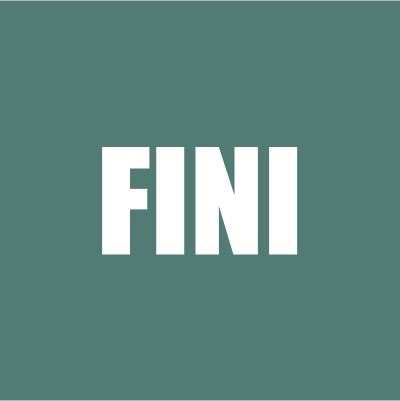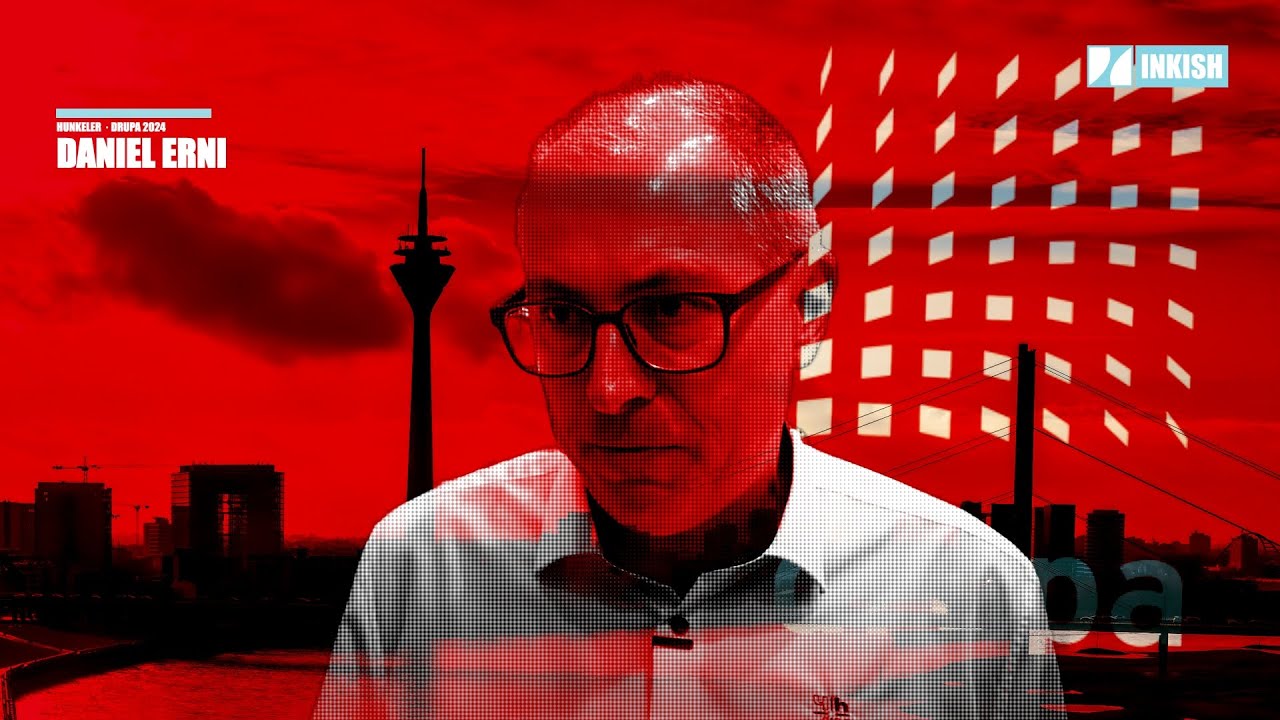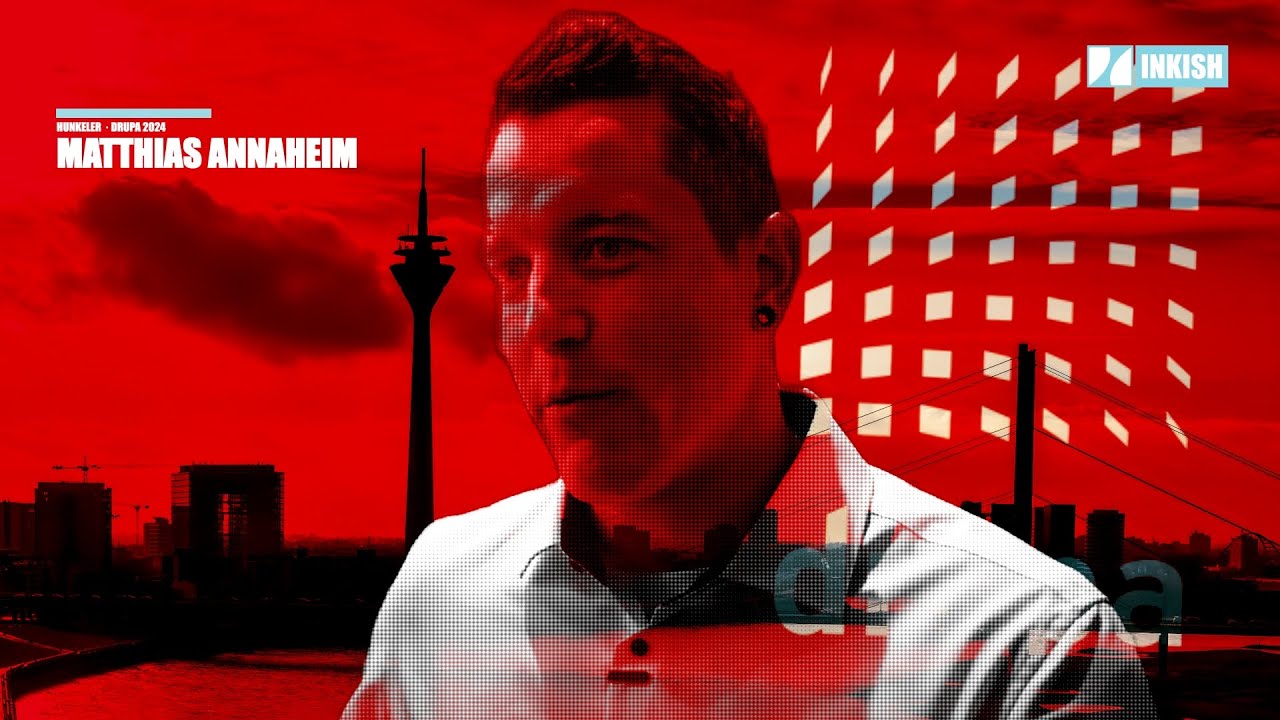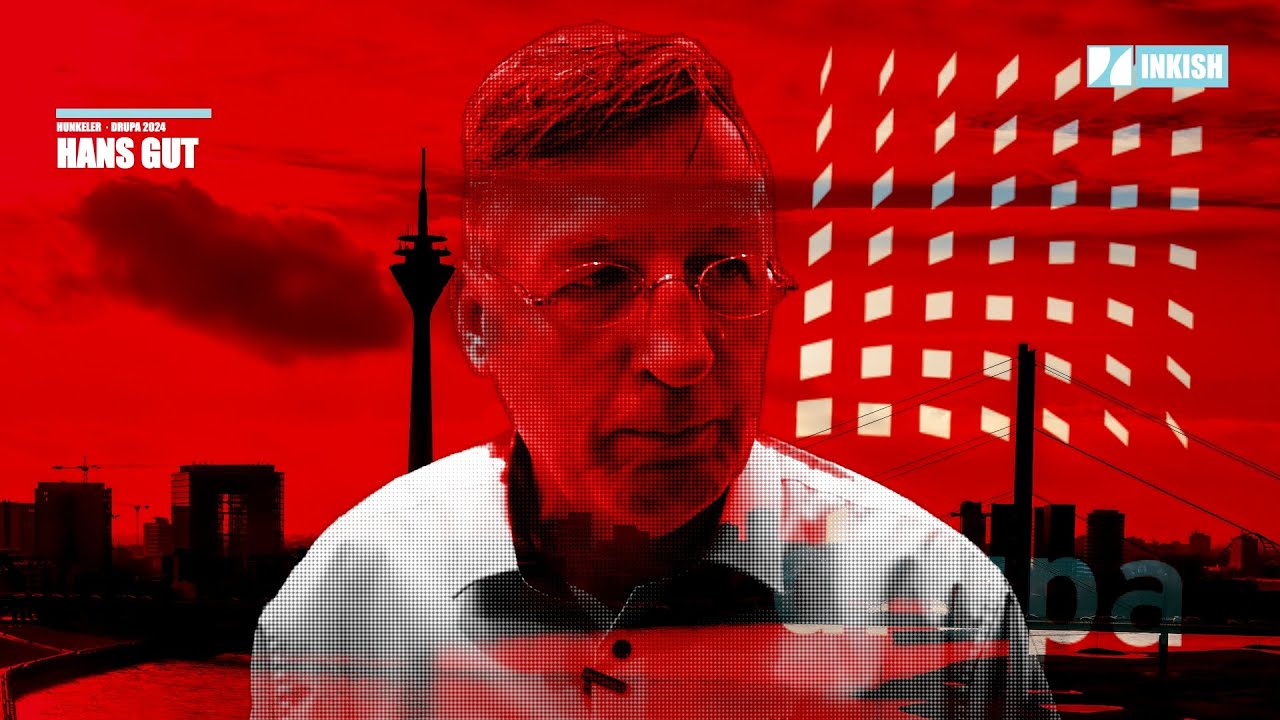INKISH.TV proudly presents: Hans Gut · VP Marketing & Partnering · Hunkeler · Switzerland
At the Argos Inspiration Days 2018 VP Marketing & Partnering Hans Gut from Hunkeler gave a speech about how Hunkeler sees the future in finishing and development of digital print.
Or haven’t had the chance to see my presentation yesterday, because it will be very similar to yesterday. So welcome here to presentation about the Finishing Innovations by Hunkeler. My name is Hans Gut. I’m responsible for marketing and partnering at Hunkeler. I will tell you a little bit about where we, as Hunkeler, see the market going of digital printing and digital print finishing, then I will tell you also a little bit about new products coming from Hunkeler this year and also tell you about our new generation of finishing equipment that we launched at the beginning of the year.
Now, I would like to start with some information about where digital print technology is moving. As you can see from that slide, there is clearly that continuous feed inkjet, the green bars here on the slide, that pages printed by continuous feed inkjet technology is growing quite fast. It’s growing from mainly modal toner continuous feed based print technology and of course it’s also growing, taking away some pages from offset printed products. But here, that slide just shows a little bit the decline of continuous feed toner printer and the growth of continuous feed inkjet printers. I’m telling that because it’s really the technology, I believe, that has a lot of potential, has been around already for a few years, but it’s definitely growing.
On the next slide, we work a little bit with Drupa, and they put out every about nine months or so their global trends report. And here I have statistics basically telling the proportion of printers reporting that more than 25% of the turnover already was from digital print technology. And as you can see in that slide here, there is a number of different printing applications, do a lot of their turnover with digital print technology, predominantly functional printers, 62%, commercial printers, already 40%, publishing printers, so books and so on, 22%, and I was surprised myself to see that already 14% for packages printers do more than 25% turnover with digital print technology.
The next slide actually shows the volume by print process. And here, you clearly see that all the top growth rates come from digital technology, with a plus of 25% is digital toner cutsheet color devices, then 11% by digital inkjet rollfed color devices, then 9% from digital inkjet cutsheet color, and then cutsheet toner mono actually, and then it goes into flexo and sheetfed offset technology.
Now I want to go back a little bit on the inkjet technology, because inkjet technology is the prominent technology where Hunkeler builds pre and post finishing equipment for. And if we look here at the forecast from ID Strategies, we had about almost 2,000 digital duplex continuous feed printers installed by the end of 2017, and that number will grow quite significantly until 2021. Overall, we see about 34% more new installations per year in 2021 compared to 2017 of such devices, so there is definitely some growth in some digital markets or niche markets, like we are in.
Another interesting, I think, study or forecast is then the growth of inkjet cutsheet printers. There we see some significant growth, especially in the B3 format sizes, and that has mainly to do with new devices that come into market or have been recently introduced, because inkjet technology basically offers lower per page print cost compared to toner prints. Of course, this is a forecast, and if we know one thing about forecasts, they are always wrong. Some forecasts, it always tells me, “Well, eventually we get it right with the numbers, it just will take longer to get there.” But I think the trend here is also very clear, cutsheet inkjet devices will grow significantly in the next few years.
A few trends we see in digital printing. Inkjet printing is growing strong. Roll inkjet printing with almost 2,000 printers installed is well established. Cutsheet inkjet printing is just starting. And then printing qualities increasing fast. Some tell me, depending on the application, it’s already as good as toner or even as offset. Okay, depending a little bit of course on the requirements, but there we see also huge requirements differences. For example, between China, Japan, and Germany there are huge differences about what is being considered good, but I think overall everybody agrees that the improvements have been made in print quality is astonishing and it’s going really fast.
Another couple of statistics from the Drupa global trends. Here it shows basically what are the top print technology investments that printers plan. And as you can see, in most of the segments digital devices are really on the very top of investments. That also shows really the trend that digital technology, print technology are really here to stay and take also the dominant market share in terms of new investments. And with that, digital printing also requires really, digital finishing, because I think it would be wrong to assume that just because you change the print technology, that you now gain significantly in faster turnaround time, in cost savings, or anything like that. I think you always have to look at the entire process of producing a product end to end. And finishing is an important part of that, because we feel already that printing itself has become a commodity and the difference is in finishing.
Now, the last couple of slides on some of the market outlook. Here are the top investment priorities based on the the global, the latest Drupa global trends report. The big investments will be made, 52% in finishing, followed very closely by print technology. And as we’ve seen before, it’s predominantly, of course, digital print technology.
So summary on digital finishing trend. We believe at Hunkeler, it’s all about automation, because with automation, you really gain productivity. Jobs length’s getting shorter and shorter and in order to do those, really productive, you require or customers need automated processes. Automation also requires a strong workflow, so having the data on the control and having the systems connected to the workflow is important, and I show you later on a little bit what Hunkeler is doing about that, run lengths getting shorter and shorter. And we think or say, “Start every project with finishing in mind first,” because, or in other words, look at the end product and then how do I get to the end product the most efficient way.
Now a few words about Hunkeler, for those to who do not know Hunkeler yet. Hunkeler is a family owned company and managed in the third generation of the family, and it has 280 employees, is located in Wikon, Switzerland, so right in the center of Switzerland. The company has been founded in 1922, so is over 95 years old and has really, was almost from the beginning in the graphic arts industry, so has a lot of experience in the paper finishing industry. A worldwide presence with our own sales and service network around the world. We have a large install base, because Hunkeler was pretty much the first company that started digital print finishing back in the ’80s. And Hunkeler works very close with all the different print manufacturers, because we believe it’s not just about the printer and finishing. It’s really about integrated solutions that have to work together.
The main applications we serve is the publish and commercial print market, then transactional transpromo, security printing applications, and direct mail are the main segments our solutions are being sold to. Here the portfolio. We have a number of different solution that Hunkeler approaches, a modular approach so that we can take different modules and build them into finishing lines to produce many different type of products from transactional transpromo pro products with dynamic coupon perforations, then of course different types of books and booklets, to newspaper and direct mail pieces. So a fairly wide variety of different products that can be produced on the flexible finishing line technology from Hunkeler. As I mentioned, we have roughly 8,000 solutions installed in the market from the beginning throughout the different generations of equipment that Hunkeler has out there and are still in operation.
A word about the new native digital Generation 8. It’s the brand new Hunkeler finishing generation that has been introduced, or has really from the beginning of this year. We already have several lines out there with customers. It is really from the ground up, a brand new finishing line technology made actually for today’s and the future market. And we say the future market, it’s really geared toward commercial print applications, meaning processing of full color offset code that stocks heavier paper, a short drum, more automation, and so on.
A couple of details about that line. The Generation 8 is ready for the growing graphic arts segment. We’re using air transport technology to really hold the sheets just with air, with vacuum, so that we can guarantee no scratching, no scuffing of paper. And of course, that technology allows also to transport different type of paper with minimal setup time, because all these different parameters can be stored on these machines then to process different type of papers, different type of application.
The Generation 8 is an addition and complimentary to our existing product line. Generation 8 is basically 20% faster and 10% wider to give really much greater productivity overall. And the all new Hunkeler workflow manager, for easy set up and operation, really sets new standards in that type of finishing industry for … it’s really the base for automation to automate, setup processes, and so on.
That’s what it looks like. The workflow manager has basically a large touchscreen overview and the main areas that we cover then with the workflow manager is chop definition, reporting, tracking, and then all the different service features that are available through that tool for really keep the machine running and have minimal or almost no down time.
Hunkeler also manufactures a number or works with a number of different partners, because we cannot do or be expert in everything. So we work very close together with Perfect Binder manufacturer, with Stitcher manufacturer company that have hundreds of years experience in building these type of products. And Hunkeler is all about integrating these technology and through the workflow manager and through software and interfaces connecting these systems, for really seamless, automated finishing processes.
We show a few examples here. On the top left, it’s an integration with sewing machines for really high end book production. Then we have an example to integrate with Muller Martini stitchers. We have integration with different printer partners and again we have worked very close with all the different printer partners that are out there to offer integrated solutions. If you have any questions about any solution that Hunkeler offers, please feel free to see us over there at the little booth from Hunkeler Finishing.
A word about the Hunkeler Innovation days. I think many of you have heard about the event. It will take place from Monday February 25 to Thursday February 28, 2019 in Lucerne, Switzerland. Here are a few pictures. We have about 90 exhibitors, so it’s in a way similar to here. A little bit bigger, had 6,000 visitors we had last time in 2017. Hunkeler organizes the Innovation days every two years and it’s really an event where Hunkeler organizes different partners and showcases different live application. When we say live application, it really means showing application from creation to the end when they go in an envelope, when they come out as a finished newspaper, or a finished book. And you can see the process and all the different vendors and suppliers that contribute to make such applications actually work, all in a small place in one hall. So you have all the subject matter experts there onsite.
So you are all invited. Please sign up at innovationdays.com. We would love to welcome you there. With that, I’m at the end of today’s presentation. Thank you very much for your attention.
































































